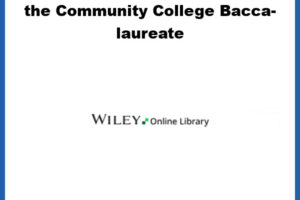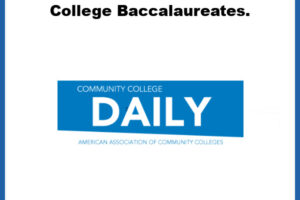Strategies for Recruiting Adult Working Learners into Community College Baccalaureate Programs
Strategies for Recruiting Adult Working Learners into Community College Baccalaureate Programs
Jason Smith, Managing Director and Founder, OHO and Angela Kersenbrock, EdD, President Community College Baccalaureate Association
The impact of a college baccalaureate on a person’s career attainment and financial success is widely understood and has been demonstrated factually. The baccalaureate degree can change individual’s and their families’ lives for generations.
The “adult working learner” segment of the higher education market stands to gain significantly from the attainment of a properly focused baccalaureate degree.
However, one of the challenges in higher education is being able to accurately profile the “adult working learner” so more precise marketing and recruitment strategies can be deployed.
Typically, “non-traditional students” or “adult learners” were defined as those over 25 who are returning to college to complete a degree.
A subset of the “adult learner” category is the student who enrolls in a community college baccalaureate degree program. These students are typically in their early 30s and are working and living in the community college’s geographic market. They often have some college experience and have attempted to complete their degree at multiple institutions.
For example, a CCB graduate in Central Florida had been enrolled in an automotive technician and auto-body program, before realizing his real passion was to be a paramedic. Once he became a paramedic, he realized, to advance professionally and economically, he needed the baccalaureate degree. He learned his local community college had a baccalaureate in health sciences that would meet his needs.
Often adult students learn of degree programs in conversations and possibly industry visits by the local college. However, this is a very time-consuming and ineffective way to recruit large numbers of adult working learners.
The following is a list of attributes we found common to the community college baccalaureate student:
- Age 24+ years old
- Financially independent of parents (which impacts financial aid)
- Lives and works in the college’s geographic market
- Has one or more dependents
- May be a single caregiver
- May not possess a traditional high school diploma
- Has delayed postsecondary enrollment
- Stopped out of college for many reasons
- Prefers to attend school part-time
- Is employed full-time
Being aware of these attributes allows community colleges to approach marketing and recruiting to appeal to this growing population.
Flexibility is Key
Prospective adult and working students need flexibility and they want to understand how they can fit school into their existing life commitments. This audience is also seeking convenience in program delivery — online or hybrid — and secondly the time of those classes — evenings or weekends.
Flexibility also means the ability to start and stop out of the degree as family, work, or finances dictate. Prospects want to know that, if they need to pause their education, they can do so without penalty. In addition to communicating about the flexibility built into programs, an effective strategy is to have required courses scheduled over a two-or-more-year period so students know when and how often required courses will be offered.
Communication is Essential
Adult learners appreciate direct communication. It is best to clearly state and demonstrate how programs are designed for the needs of this audience.
- Some schools utilize a “week in the life” graphic to demonstrate how different students fit courses and studying into their busy lives.
- Other schools employ testimonials as a tool for communicating how current students fit classes into their schedules.
- Colleges should also communicate about the flexibility available across all areas of the student experience including financial aid, faculty, office hours, career services, and tutoring services. Many tutoring services offer 24 hour, 7 days/week services (Tutor.com).
Acknowledge their Perspective & Promote the Positive
Due to setbacks in their previous college experience, these adults may bring negative emotions — anxiety, fear, apprehension — to the process of looking for a new school. Some wonder: “will this time be different?” As research in New Directions for Student Services indicates, many adult learners possess a “lack of self-confidence upon reentry to college.”
From a marketing perspective, recognizing and considering these emotions is critical:
- Ensure marketing materials have a warm, open and inviting tone.
- Streamline intimidating processes such as admissions applications, financial aid forms, and proof of residency. Simple and accessible systems that are available at any time in any place are key for the adult working learner.
- Engage with prospective students in non-threatening environments. Some colleges offer open houses, family pizza nights and career fairs to welcome potential students back to college and onto campus. In today’s environment, Zoom open houses, and having student services personnel available on virtual platforms encourages adult students to make important connections.
- Use calls to action, via texts, emails, and phone that encourage personal interactions with supportive admissions and advising staff. Keep in mind, these potential adult students may choose to remain anonymous for a long time as they are often hesitant to engage. Use multiple avenues for engagement and let your potential adult students choose the communication method they feel most comfortable with.
Once the college has captured the attention of adult learners, they often need to provide additional details before the students commit. Based on ethnographic user research and broad-based surveys with adult students conducted by OHO, we identified the key content adult students seek during the admission process.
Program Details
Program curriculum is a top interest for prospective adult students. Every higher education marketing plan needs to include a budget to build out a robust program section on its website that includes:
- Program overview with course descriptions.
- Faculty profiles – prospects are interested in qualifications.
- Tuition or cost per credit and anticipated itemized costs for the entire program. This is necessary for students to visualize the return on their investment.
- Financial aid opportunities including scholarships, emergency loan programs, food pantries, rent assistance and guidance on how to activate and enroll in employer tuition reimbursement options.
- Academic calendar with start dates for the upcoming 18-24 months. Institutions that are serious about focusing on adult working learners should try to have academic year and semester start dates for at least two years. Adults with school age children and jobs need a great deal of planning time.
These prospects also seek outcome data such as placement rates, salaries, companies that hire program graduates, local industry partnerships, and internship opportunities, etc.
Adult students care much less about the “traditional” or “on-campus” student experience and more about the quality of the classroom experience. They are also curious about the community of learners they are considering joining. Having other students who look like them and who are managing a similar school-work-family balance is critical for these students to feel a sense of belonging.
Adult learners do not like “placing” themselves in the classroom. They respond positively to photography that shows the outcome – alumni working in the career or role they will have after degree completion.
Adult students are focused on the end results, they are very clear and verbalize they are pursuing the baccalaureate to improve their economic prospects, and to model to their children the value of higher education.
Accreditation and Non-Profit Status
With the negative press facing some private for-profit schools, potential adult students are aware of the risks that may be associated with them. Adult students respond positively to the credibility afforded by a third-party accrediting agency — even when they have never heard of the accrediting body. Adults also respond positively to a non-profit moniker, i.e. XXX State College, or YYY Community College. Both help potential students feel more comfortable and see the value of a college degree.
Tuition and Aid
Transferred credits from other programs and colleges mean lower tuition to the prospective adult student. In OHO’s research, prospects tend to “mentally discount” published tuition costs because they expect to receive some credit for previous course work. They rarely expect to pay full tuition and they love to be reassured that their credits will transfer. We encourage institutions to highlight any scholarships, discounts, corporate partnerships, or credit transfer policies loudly and directly online and in digital communications.
Campus Credibility
A physical campus can be another credibility-building validation point for adults. A campus means that the college is not a “fly by night” institution and it can help build trust. If your college draws mostly from a local region, the physical campus offers a means of recourse if there is a problem. Prospects think: “If I have an issue with my bill or enrollment, I can always get in my car and go see someone.” A higher education marketing plan should always spotlight the accessibility of campus services – even while promoting fully online programs.
Choice Matters
When asked, prospective adult learners report they value options. Prospective students like to know they can choose the program and delivery methods that best fit their career goals and current life commitments.
Quick and Frequent Starts
Adult students do not want to wait six months to enroll. They want to start their degree quickly, finish quickly, and get onto the career (and higher salary) that the new degree will afford them. This is, of course, balanced with the reality that most adult students may be working and need to attend part-time. Creative scheduling, such as six-week courses, offering courses during holiday breaks, etc. are all welcome options.
Focus on Outcomes
The potential impact a degree provides for graduates is one of the most important deciding factors for adult working learners. Outcomes, illustrated by alumni testimonials, job placement numbers, salary data, are critical and should be front and center in all communications.
These messaging strategies are designed to guide institutions, marketing departments and program faculty as they evaluate their baccalaureate design and marketing strategies. From print brochures and billboards, to television and radio ads, social media marketing and websites, these research-tested messages can serve as a starting point for forming a communication strategy that reflects the unique needs of adult learners and their stories.




